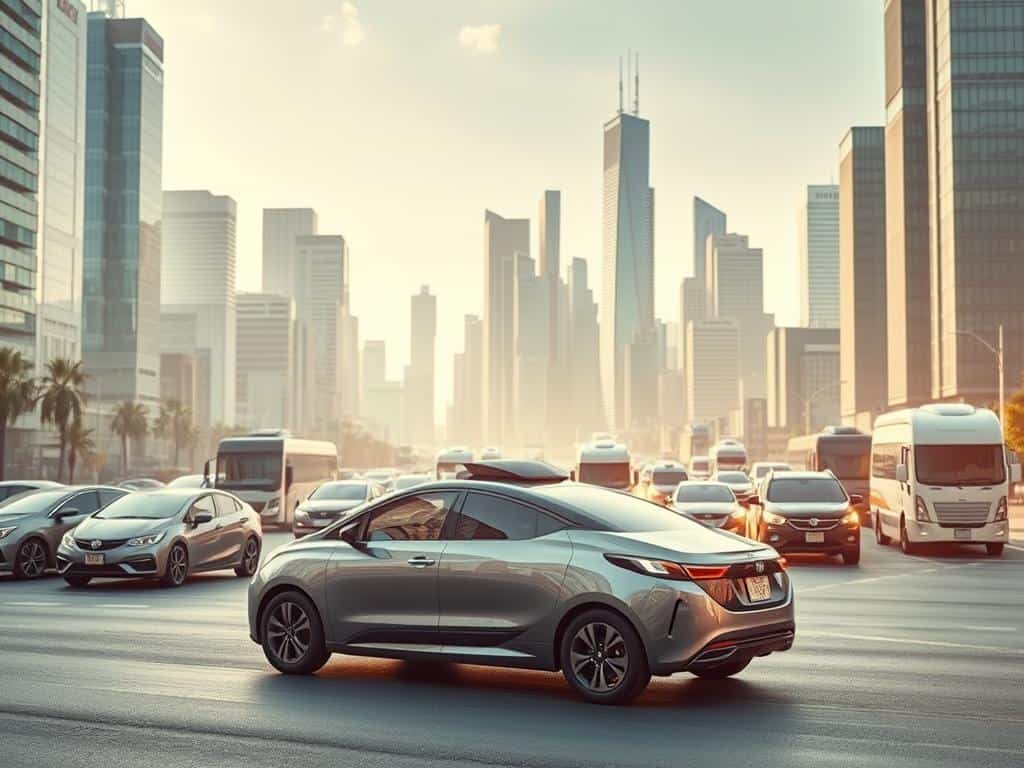
Did you know the global market for self-driving cars could hit $300 to $400 billion by 2035? This huge number shows how fast these cars are changing our way of getting around. With new tech in automation, machine vision, and AI, they’re set to change our view of travel.
As someone watching this tech change, it’s key to understand what it means for all of us. This includes consumers, those making laws, and tech creators.
Key Takeaways
- The autonomous vehicle market could reach $300 to $400 billion by 2035.
- Self-driving cars rely on advanced automation and AI technology.
- Autonomous vehicles are changing perceptions of transportation.
- Understanding this shift is key for consumers and policymakers.
- The future of mobility is on the brink of big changes.
- Technology developers are racing to innovate in the autonomous realm.
The Rise of Autonomous Vehicles
Exploring the world of autonomous vehicles, we see the power of self-driving cars. These cars use advanced tech to drive on their own, showing us what the future of travel might look like.
What Are Autonomous Vehicles?
Autonomous vehicles, or self-driving cars, use sensors, cameras, and AI to drive without a person. The NHTSA has five levels of automation, from no automation to full automation. This helps us see how far the tech has come.
Current State of Technology
Today’s autonomous vehicles are making big strides. Many cars can keep their lane and adjust speed on their own. Companies like Tesla, Waymo, and Cruise are leading the way, aiming for cars that can drive fully on their own. The path is complex, but the goal is clear.
Regulatory Landscape for Self-Driving Cars
The rules for self-driving cars are getting more complex. Federal laws and state rules are changing fast to keep up with new tech. It’s important for everyone involved to understand these changes.
Federal Laws and Guidelines
Federal laws are the base for self-driving car rules. The National Highway Traffic Safety Administration (NHTSA) makes guidelines. These help states create their own rules while keeping safety standards the same everywhere.
State-Level Regulations
States are playing a bigger role in self-driving car rules. Each state has its own rules, based on what they think is best. For example, Florida and California have rules that let companies test and use self-driving cars, but they also check safety closely.
Impact of Legislation on Deployment
Lawmaking is key for self-driving cars. Federal laws set the big picture, while state rules give the details. This mix can affect how easy it is for companies to start using self-driving cars. Keeping up with new laws is important for those in the industry.

Challenges Facing Autonomous Vehicles
Exploring the growth of self-driving cars, I see many obstacles. These challenges could affect their success and how people view them.
Safety Concerns and Public Trust
Safety is a big issue for self-driving cars. Tragic accidents have made people question their reliability. This has led to fears and a lack of trust, which is key for their adoption.
People compare the safety of these cars to the risks they might face. It’s important for companies to be open about their safety measures. This will help build trust with users.
Technical Limitations and Road Conditions
The tech in self-driving cars faces specific hurdles. Different road conditions make navigation tricky. For example, complex intersections and unexpected obstacles are challenges.
Weather like snow, rain, or fog also affects their performance. This inconsistency worries people about their ability to work in real-world situations. It impacts how they are seen and accepted.
Market Competition and Innovation
The car industry is more competitive than ever. Companies, big tech and car makers alike, are pouring money into autonomous tech. This push for innovation is good but also creates pressure.
Quality and safety might suffer as companies rush to get their products out. The outcome of this competition will shape the future of self-driving cars.
Conclusion
The future of self-driving cars is exciting and full of change. Technology is advancing fast, and rules are getting clearer. But, there are big challenges ahead, like making sure these cars are safe.
Everyone involved, from new companies to big car makers, is working hard. They want to win over people’s trust in self-driving cars. This is key for their success.
Rules are very important for the growth of self-driving cars. New laws will help us see these cars on the roads more often. Rules are not just a hassle; they help keep us safe and moving smoothly.
Even though there’s a lot of competition, new ideas are making self-driving cars better. We need to watch how policy, tech, and what people think work together. I’m hopeful that self-driving cars will change how we travel, but safety and trust must come first.